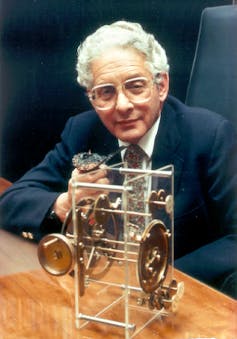Millions of scientific papers are published globally every year. These papers in science, technology, engineering, mathematics and medicine present discoveries that range from the mundane to the profound.
Since 1900, the number of published scientific articles has doubled about every 10 to 15 years; since 1980, about 8% to 9% annually. This acceleration reflects the immense and ever-growing scope of research across countless topics, from the farthest reaches of the cosmos to the intricacies of life on Earth and human nature.

Derek de Solla Price wrote an influential book about the growth rate of science.
The de Solla Price family/Wikimedia Commons
Yet, this extraordinary expansion was once thought to be unsustainable. In his influential 1963 book, “Little Science, Big Science… And Beyond,” the founder of scientometrics – or data informetrics related to scientific publications – Derek de Solla Price famously predicted limits to scientific growth.
He warned that the world would soon deplete its resources and talent pool for research. He imagined this would lead to a decline in new discoveries and potential crises in medicine, technology and the economy. At the time, scholars widely accepted his prediction of an impending slowdown in scientific progress.
Faulty predictions
In fact, science has spectacularly defied Price’s dire forecast. Instead of stagnation, the world now experiences “global mega-science” – a vast, ever-growing network of scientific discovery. This explosion of scientific production made Price’s prediction of collapse perhaps the most stunningly incorrect forecast in the study of science.
Unfortunately, Price died in 1983, too early to realize his mistake.
So, what explains the world’s sustained and dramatically increasing capacity for scientific research?
We are sociologists who study higher education and science. Our new book, “Global Mega-Science: Universities, Research Collaborations, and Knowledge Production,” published on the 60th anniversary of Price’s fateful prediction, offers explanations for this rapid and sustained scientific growth. It traces the history of scientific discovery globally.
Factors such as economic growth, warfare, space races and geopolitical competition have undoubtedly spurred research capacity. But these factors alone cannot account for the immense scale of today’s scientific enterprise.
The education revolution: Science’s secret engine
In many ways, the world’s scientific capacity has been built upon the educational aspirations of young adults pursuing higher education.

Funding from higher education supports a large part of the modern scientific enterprise.
AP Photo/Paul Sancya
Over the past 125 years, increasing demand for and access to higher education has sparked a global education revolution. Now, more than two-fifths of the world’s young people ages 19-23,…



